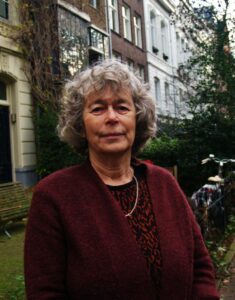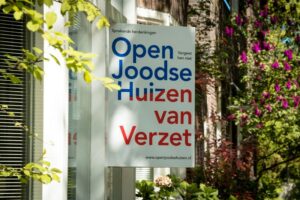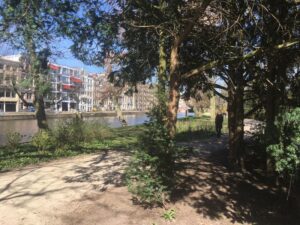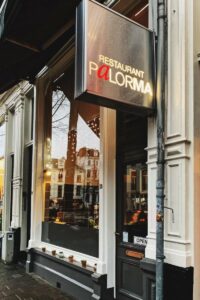See amsterdam through the eyes of A local
Discovering Amsterdam with a local is an experience in itself. The best part of Amsterdam are the Amsterdammers – these sassy, whimsical, pragmatic, and unapologetically free people.
In our lifetime in Amsterdam, we’ve come to meet some truly amazing locals. People of different ages, with different jobs, memories, voices. They have one thing in common: a deep personal connection with Amsterdam. Many have been living here for generations.
We asked them to share their stories of Amsterdam. Their favorite places, things to do, what they are proud of and what they dislike. These conversations are unfiltered and honest, just like the real Amsterdam we like to show to our guests. Enjoy a glimpse of Amsterdam with a trusted local!
 “Feel free to interrupt and cut me off if it gets boring – I have a tendency to talk endlessly.” That’s the first thing Denise Citroen mentions when we sit down with tea and pie at her cosy home in the Plantage neighborhood.
“Feel free to interrupt and cut me off if it gets boring – I have a tendency to talk endlessly.” That’s the first thing Denise Citroen mentions when we sit down with tea and pie at her cosy home in the Plantage neighborhood.
It’s a suitable setting for our talk. Firstly, because it’s the neighborhood where Denise’s family has lived for generations. And secondly, because homes are an important part of Denise’s story. She is the creator of Open Jewish houses, which has grown into a well known, nationwide project around the memorial of World War II.
Two weeks before Denise was born, in 1952, her parents moved to a lush green village just east of Amsterdam. “At least I was conceived in Amsterdam, and as soon as I turned 18, I moved back – they can’t keep me in the suburbs!” She studied biology and ecology, but never worked in that range.
It seems to us that there’s a wide variety in things you have done throughout your life. How would you describe that evolvement of your professional career?
“When I finished studying, there was no work in biology or ecology. I ended up working in what interested me: the Third World movement, for development organizations. It became the thread in my life: turning what interested me, into my job. Looking back, I see the thread. ‘Where’s the energy, where’s something happening?’ That’s where I’d go.
While the Third World movement declined, I had my son. That made me realize I knew very little about my – and now his as well – heritage. What would I tell him? I am of Jewish descent but not raised Jewish. I had no names, no stories, no pictures of my murdered family. I wanted a clear start for him, with known stories. So I dove into genealogy. That happened to be the years that Steven Spielberg founded the Survivors of the Shoah Foundation. After Schindler’s List, a lot of people approached him and asked: “Can you film my story too?”
Spielberg decided to spend the royalties of Schindler’s List on this project. He wanted to interview 50.000 people who survived the Holocaust and film them all. It was the 1990’s; internet was only for universities. It was a scale beyond everything up to then.
Oral history wasn’t a big thing at all – actually it was looked down upon by historians. They considered it an unreliable source. It was proven facts versus subjective stories which may have been altered from person to person. However, I believed in it. My parents’ generation didn’t share stories about World War II. The only way I could tell stories to my son, about his heritage, was shaping them myself. I realized: nobody can simply pass on stories. It is a process: you have to swallow the previous generation’s story and add your own flavour. That added layer of your own, your perspective, becomes part of the story. That’s how I got involved in storytelling, sharing and passing it on.
Steven Spielberg’s project appealed to you and you ended up being involved. How come? It couldn’t really be a simple phone call ‘hey Steven, great idea, I’ll help you!?’
Hahaha…! Well, actually something in that range..! Rumor went around about the idea. I was active in a social network for the ‘Second Generation’ – children of Holocaust survivors. I had an acquaintance who had a contact in Los Angeles, who was called by someone from Spielberg’s project. They were looking for coordinators and interviewers all over the world. Via via I heard when Spielberg’s contact person would be in Amsterdam, and that he would stay in hotel The Grand. So I went to The Grand and left a note for him with the concierge: ‘Tomorrow we have a Second Generation meetup in a cafe. This is the address; if you’d like to join, please come.’
And that’s what he did. He turned up and we had a sort of job interview in the cafe. He didn’t need to ask whether I had any contacts – there were about 75 people there. A week later, I was hired.
I was the coordinator for the USC Shoah Foundation in the Netherlands. We spread the news about the project and survivors could contact us. We interviewed 1000 people. You can actually watch the interviews at the Hollandsche Schouwburg, the Holocaust Memorial in Amsterdam. 
How did you come up with the idea for Open Jewish Houses?
After Steven Spielberg’s project, I kept thinking about a continuation of the storytelling. I spoke with hundreds of survivors and they all said: ‘Make sure that the next generations know our stories. Make sure you pass them on.’
So my next project was to ask grandchildren of survivors to watch their grandparent’s interview and comment on it. I bundled these stories in a book*.
And then, one summer day in 2011, suddenly the idea popped into my head. I clearly remember the moment: I was on my bike, cycling along the Amstel river. I was thinking back to something which happened a few months earlier. I was at home and the doorbell rang. There was a family from Israel, telling that they lived in my house up to World War II. Of course I invited them in. They told me about their daily life in this house, of parties and birthdays. I felt like I became part of their family history – which was overwhelming and amazing!
You have to know: this neighborhood was about 80% Jewish. So I asked around and many neighbors had had similar experiences: people had rang their doorbells and shared stories of life before and during the war.
So, my bike ride that summer day. I thought: when people think of the Holocaust, they think of Nazi boots, people being dragged out of their houses – only horrific stories. They do not think of an actual family, living in a house, having a normal daily life like you and me. If you bring back the story of their pre-war life, it should be easier to live in that house. Together with the current residents, I collected the stories of the former residents of 13 houses in this neighborhood. And I thought this ‘on the spot storytelling’ was not only valuable for the residents, but for everybody! It gives a face to people, Holocaust victims, on a scale that you can grasp – right here in a home where you are sitting.
Open Joodse Huizen (Open Jewish Houses) is a – by now nationwide – project around the Dutch World War II memorial. On 4 (Memorial Day) and 5 (Liberation Day) May, there’s an extended programme of storytelling sessions in houses. The stories are told by someone related to the World War II family or the current family, and are an opening for conversations on the spot. 

© OJH
From a dozen houses in the Plantage neighborhood to hundreds around the country, with 10.000 visitors per year. Did you expect it to be so successful?
No, I didn’t. I didn’t think in terms of success or growth. In the end, it’s still about one house with one family. That stays the base, even when you multiply it by hundreds. If you lose the perspective of one, you lose the purpose of the project. It was the same with Spielberg’s project: it’s not a competition of having bigger numbers. In the end, even 52.000 people were interviewed. But that’s still 52.000 times one person. That’s the scale. I didn’t even make a year plan.
How would you explain its success?
Contact with others, forming a remembrance community. People gather in a home – a small scale, personal setting. Even while people don’t know each other, they share an interest and maybe even a link with the person of the story. And then they want to share their bit of the story too. ‘Their child was my classmate.’ ‘Ah, he was my playmate!’ And they share memories, bringing a person back to life.
Storytelling is much more graspable than writing and reading. Don’t get me wrong; writing and reading are very important. But this is more accessible. Everybody can tell a story, even if it’s just two sentences. The small scale, personal interaction – a place and moment in time where people connect around a story that interests them.
Have your Amsterdam Jewish roots shaped you in what you do?
Yes. Once I started the genealogy research, I felt even more like I belong in Amsterdam. Some of my ancestors played a big role in this city. My great great grandfather started a famous diamond and jewelry shop in the Kalverstraat, the main shopping street, in the 1850’s. I even discovered that an earlier ancestor started that business right here around the corner, on the soil which is now Artis, the zoo. That’s where he built his workshop and got into the jewelry business.
So the neighborhood which is so much your story, turned out to be part of your family’s story for centuries?! Wow! What does your neighborhood mean to you? What makes you feel at home, the vibe, places you visit, special stores or spots you like to go?
It is so amazing to live here. I feel lucky every day, especially when I go for walks. Then I enjoy the neighborhood even more than when quickly going around by bike. The big thing is that there’s só much green. It’s the greenest living area of the city. On my walks, I take unpaved paths. I love the feeling of being in the lively city and in quiet nature at the same time.
There’s a strong community feeling, social cohesion. I really won’t leave this street. I even talked with neighbors about options for swapping homes when I can’t climb the stairs to my floor anymore!
To mention a slightly less positive aspect as well: it’s a quite white neighborhood – there is not much diversity. There are not that many shops and the average age is quite high – well, that last fact I myself am contributing to as well by now, haha..!
What does a day in Amsterdam look like for you?
Nowadays, being retired, my walks are my favorite thing to do. Every day I walk a circle around the zoo. I started walking only about 1,5 years ago. Up till then I did everything by bike, fast. Now that I have more time, I realize walking is great for your health and meanwhile I meet so many people. I always end up having chats here and there.
And I started to feed the crows! By now they know me; we have our spots where we meet. People have gotten to know me as ‘the lady with the crows’, haha! The biology researcher in me has woken up. I start to notice their territories. I enjoy observing. Not only the crows – in general I like observing the world and everything and everybody on it.
What are your favorite spots in Amsterdam?
Generally, it’s everywhere where I can enjoy nature close to the city. I love cycling through the rural north area. Go to the north bank of the river IJ and cycle through the meadows, passing by old picturesque villages. You don’t need to travel to wherever far to have an ultimate holiday feeling!
Another favorite is going to the movies, especially art house movies. Eye is very nice – the film museum and art house cinema with a beautiful view over the river from their cafe restaurant. And The Movies, one of the oldest cinemas of town with its art deco interior. When I go to The Movies, I like to stroll around the Haarlemmerstraat as well – one of the nicer shopping streets, with many sympathetic independent entrepreneurs.
Favorite cafes, restaurants?
Right here in my neighborhood, I sometimes sit down at cafe restaurant De Plantage or cafe Koosje. Every Amsterdammer knows these two places. Two lesser known spots yet definitely worth a visit: Pizza Palorma has been here for about 30 years – a Turkish family business with a very friendly, personable staff. And recently, a Syrian family opened a snackbar with delicious Middle Eastern food and a nice, heated terrace. Now I realize: after all we do have some diversity in our neighborhood too! 

A bit further east, I like to go to Park Frankendael and sit at restaurant Merkelbach. The park is small and quiet, and the restaurant is located in a beautiful 17th century buitenplaats or mansion.
What do you consider the most valuable quality of Amsterdam?
The scale. It’s a village compared to cities like New York, Paris, London – even Berlin. Well, Berlin has that village feel in its neighborhoods too, yet the total surface is much bigger. In Amsterdam, most things are within a 20 minutes bike ride reach.
And Amsterdammers are easy going, going with the flow. It’s easy to have little chats, to be polite to each other, to help each other if necessary. And even now that the scale of tourism has become a problem, I am convinced that we will find a way to rearrange.
If you could put a message on a billboard for people coming to visit Amsterdam, what would it be?
Go beyond the surface, further than the highlights. Dive into the history, into the stories behind places. Amsterdam has so much more to offer than the ‘usual suspects’!
* One story out of thousands – grandchildren about the heritage of the Holocaust. (Een verhaal uit duizenden – kleinkinderen over de erfenis van de Shoah) Denise Citroen, Boom 2009






1 thought on “Amsterdam with a local: Denise Citroen”
Nice story Eva